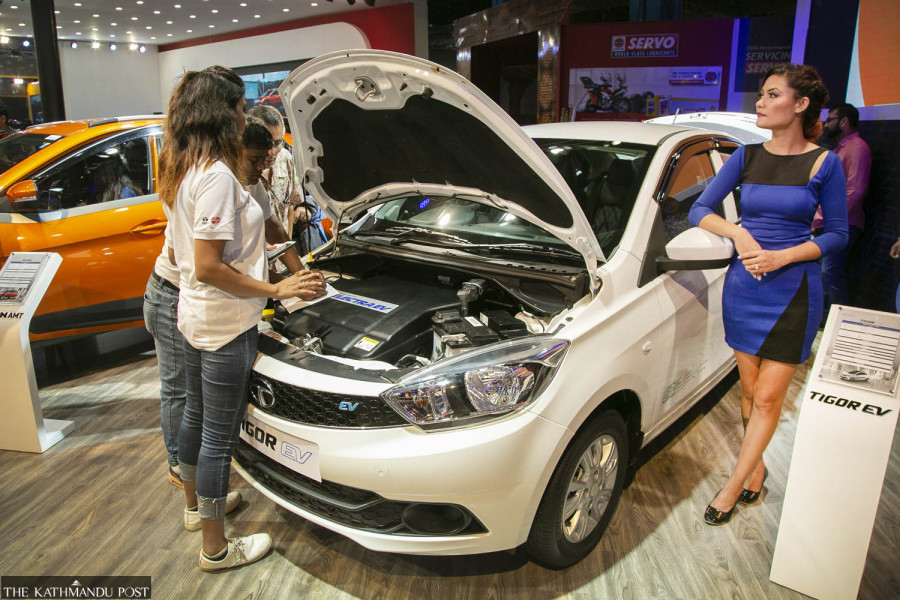Money
Nepal EV imports leave fossil fuel vehicles behind
Purchase data signal shift in automobile landscape, driven by the country’s policy, financing, environmental goals.
Krishana Prasain
Electric vehicle imports in Nepal have surpassed those of traditional gas-powered vehicles, marking a milestone in the country’s transition to cleaner transport.
In the first half of the current fiscal year, which ended mid-January, Nepal imported 12,974 four-wheelers—including passenger buses, microbuses, and private vehicles.
Of these, 7,349 units were EVs, putting Nepal on track to replace petroleum-based light vehicle imports with EVs by 2031, which also aligns with its international commitments.
The rise in EV adoption in Nepal comes with multiple benefits.
EVs are environment-friendly, with zero tailpipe emissions, which helps cut air pollution—a major issue in Nepal’s urban centres. They also contribute to lower greenhouse gases, aligning with the country’s commitment to combating climate change.
From an economic perspective, EVs reduce dependency on expensive fossil fuel imports, which can over time help improve Nepal’s trade balance.
The cost of operating and maintaining EVs is significantly lower than maintenance of traditional internal combustion engine vehicles, offering long-term consumer savings. Additionally, the growing EV market has the potential to create new business opportunities, such as charging infrastructure development and EV maintenance services.
According to auto dealers, EVs also provide a quieter and smoother driving experience, making them increasingly popular among consumers seeking modern, eco-friendly transport options.
EV imports from China have grown rapidly, accounting for most of Nepal's EV purchases.
According to the Department of Customs, Nepal imported EVs worth Rs17.45 billion in the review period, with Rs14.36 billion paid for Chinese imports. EVs from India totalled Rs2.93 billion, while South Korea, Germany, and the US collectively accounted for Rs162 million worth of vehicles.
Customs data shows that 5,434 EVs were imported from China, including passenger buses, microbuses, and private vehicles. Meanwhile, 1,890 EVs came from India.
Overall, Nepal’s automobile imports grew 32 percent in the first six months of the fiscal year, reflecting a recovery in the auto sector.
“The decline in bank interest rates has spurred the import of private and commercial vehicles, especially in the passenger-carrying segment,” said Rajan Babu Shrestha, vice-president of the Nepal Automobile Dealers Association.
Bank interest rates, which previously hovered at 12–13 percent, have dropped to 6–7 percent, attracting more buyers. However, Shrestha noted that sales of construction vehicles, like trucks and tippers, have fallen behind due to reduced government infrastructure spending.
Nepal’s EV market has seen remarkable growth, with a 149 percent rise in imports last fiscal year ended mid-July. In that period, the country imported 11,701 EVs worth Rs29.48 billion.
Traders attribute the surge in EV sales to tax waivers, lower financing costs, and various models catering to different customer needs. Popular EVs are priced between Rs4 million and Rs5.5 million, though higher-end models are also witnessing strong demand.
Despite the government increasing EV import duties by 10 percent in the current fiscal year’s budget, sales have been robust as banks finance up to 90 percent of the vehicle’s cost.
Economist Govinda Nepal cautioned against viewing the rise in automobile imports as a sign of economic recovery. “EVs largely drive the current boost in imports due to favourable taxes and bank financing, not an increase in income or employment,” he said.
Nepal also imported 38,501 motorcycles worth Rs3.97 billion in the same period and 64,416 unassembled motorcycles worth Rs8.25 billion. Likewise, electric two-wheelers are gaining traction, with 5,143 units worth Rs486.10 million imported in the review period.
While the growing adoption of EVs contributes to reduced environmental impact and helps meet Nepal’s climate goals, Govinda Nepal highlighted that it has yet to boost the broader economy. “Importing EVs generates revenue for the government, but their impact on economic activity remains limited,” he said.
Liquidity in banks has increased as consumers save more, partly due to the recent embezzlement scandals in cooperatives. However, this money remains largely idle, he added.
As EVs dominate the market, Nepal’s shift to sustainable transport is evident.
The country’s embrace of EVs aligns with global trends and signals a cleaner, more sustainable future for its transport sector, said Nepal.




 7.12°C Kathmandu
7.12°C Kathmandu














